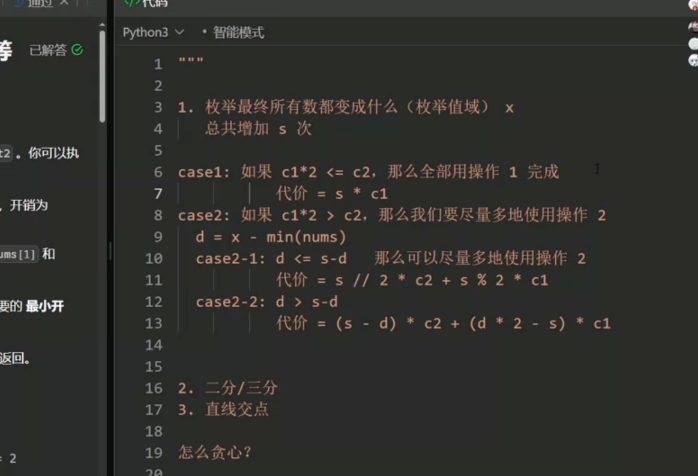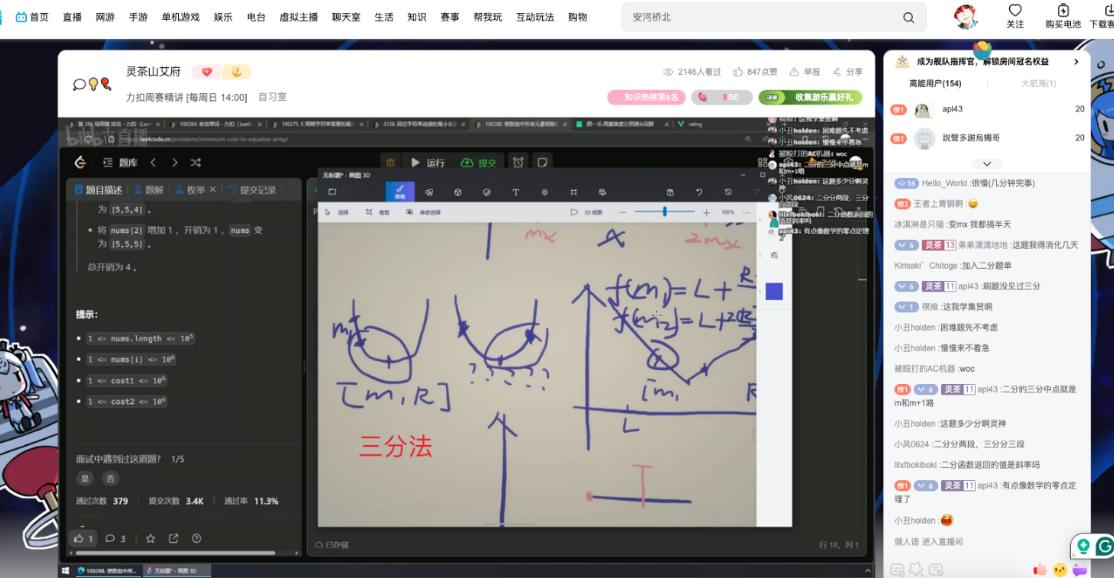周赛 Weekly Contest 396
https://leetcode.cn/contest/weekly-contest-396
100284. Valid Word
- We need to know how to iterate each character in a string
- Also, need to know how to compare the character
- The
ord()function returns the number representing the unicode code of a specified character. - The
charconvert a
- The
class Solution:
def isValid(self, word: str) -> bool:
if len(word) < 3: return False
validCharDic = {}
vowelCharDic = {
'a': True,
'e': True,
'i': True,
'o': True,
'u': True,
'A': True,
'E': True,
'I': True,
'O': True,
'U': True
}
cononant = {}
for i in range(0, 26):
validCharDic[chr(ord('a')+i)] = True
validCharDic[chr(ord('A')+i)] = True
if chr(ord('a')+i) not in vowelCharDic:
cononant[chr(ord('a')+i)] = True
cononant[chr(ord('A')+i)] = True
for i in range(10):
validCharDic[str(i)] = True
isValid = True
hasVowel = False
hasConstant = False
for i in range(len(word)):
if word[i] not in validCharDic:
isValid = False
if word[i] in vowelCharDic:
hasVowel = True
if word[i] in cononant:
hasConstant = True
return isValid and hasVowel and hasConstant
The English Character Arrays
ii = "1234567890"
vowelW = "aeiouAEIOU"
lowercaseW = "abcdefghijklmnopqrstuvwxyz"
uppercaseW = "ABCDEFGHIJKLMNOPQRSTUVWXYZ"
100275. Minimum Number of Operations to Make Word K-Periodic
https://leetcode.cn/problems/minimum-number-of-operations-to-make-word-k-periodic/
kdividesword.length.
class Solution:
def minimumOperationsToMakeKPeriodic(self, word: str, k: int) -> int:
targetDic = {}
i = 0
while i < len(word):
# print(i, word[i: i+k])
if word[i: i+k] not in targetDic:
targetDic[word[i: i+k]] = 1
else:
targetDic[word[i: i+k]] += 1
i+=k
# print(targetDic)
target = ""
maxCnt = 0
for key in targetDic:
if targetDic[key] > maxCnt:
target = key
maxCnt = targetDic[key]
# print(target)
cnt = 0
i = 0
while i < len(word):
if word[i: i+k] != target:
# print(i, k)
cnt+=1
i+=k
return cnt
3138. Minimum Length of Anagram Concatenation
https://leetcode.cn/problems/minimum-length-of-anagram-concatenation/description/
anagram
An anagram is a word or phrase formed by rearranging the letters of a word or phrase, typically using all the original letters exactly once.
concatenation
- 1, 2, 3, 4, 5
- 2, 4, 6, 8
- 3, 6, 9
- let n =9
- 8(yes), 7, 6(not), 5, 4(not), 3(don't), 2(don't),
Ideas
- from N to 1, find the k which can divide N
- for k, check if k * 2 is not available, if yes, k is not available too
- check if k satisfy the rule: the anagram of word(len k) can concatenate S.
class Solution:
def minAnagramLength(self, s: str) -> int:
minLen = len(s)
failedIndice = {}
N = len(s)
di = 2
while N // di >= 1:
if N % di != 0:
di += 1
continue
n = N // di
di += 1
# print(n)
if n * 2 in failedIndice:
failedIndice[n] = True
continue
firstStr = "".join(sorted(s[0: 0+n]))
j = 0+n
# print("j", 0, j)
while j < N - n + 1:
secondStr = "".join(sorted(s[j: j+n]))
if firstStr != secondStr:
# print(0, j, firstStr, secondStr)
failedIndice[n] = True
break
j += n
if n not in failedIndice:
minLen = n
# print(failedIndice, minLen)
return minLen
100288. Minimum Cost to Equalize Array
https://leetcode.cn/problems/minimum-cost-to-equalize-array/description/
Modulo
- 枚举法
- 二分法、三分法
- 直线交点
Since the answer may be very large, return it modulo 109 + 7.
class Solution:
def minCostToEqualizeArray(self, nums: List[int], c1: int, c2: int) -> int:
MOD = 1_000_000_007
n = len(nums)
m = min(nums)
M = max(nums)
base = n * M - sum(nums)
if n <= 2 or c1 * 2 <= c2:
return base * c1 % MOD
def f(x: int) -> int:
s = base + (x - M) * n
d = x - m
if d * 2 <= s:
return s // 2 * c2 + s % 2 * c1
return (s - d) * c2 + (d * 2 - s) * c1
i = (n * M - m * 2 - base + n - 3) // (n - 2)
return min(f(M), f(M + 1)) % MOD if i <= M else \
min(f(M), f(i - 1), f(i), f(i + 1)) % MOD

